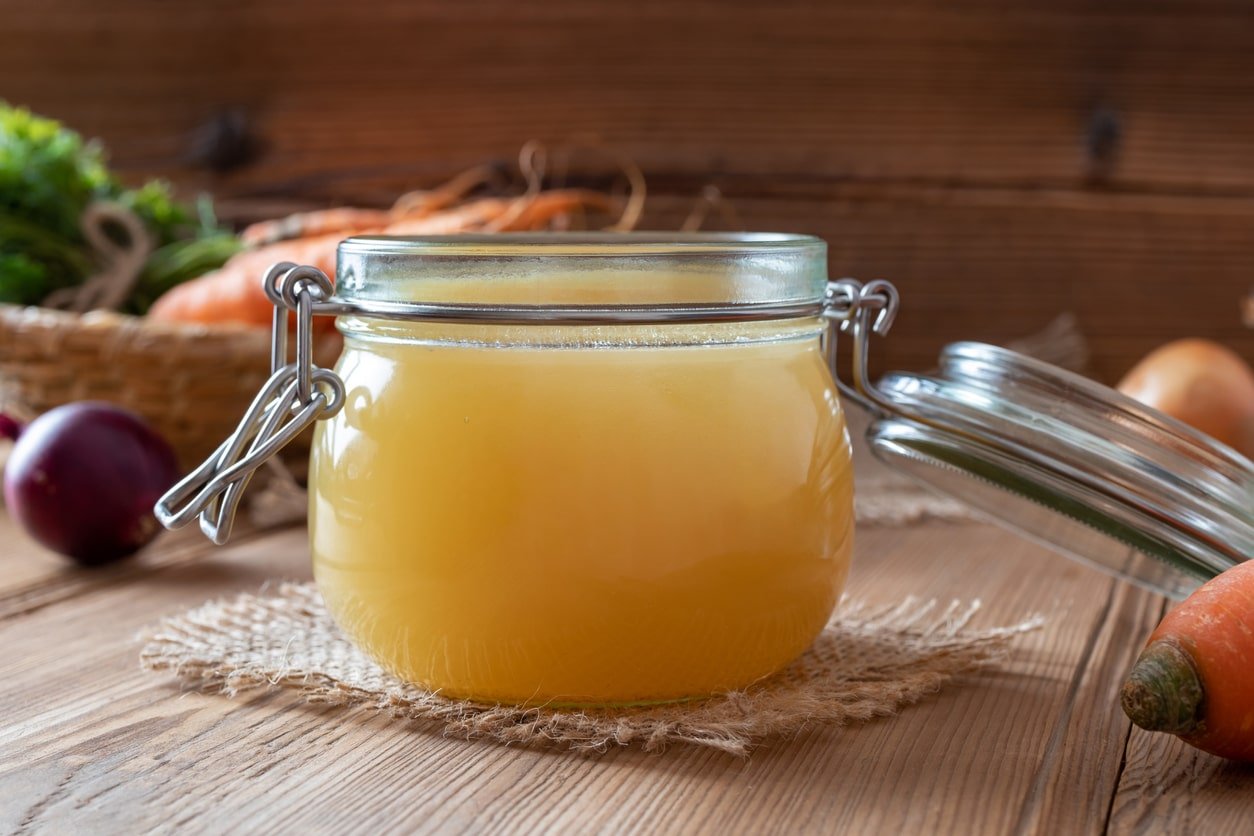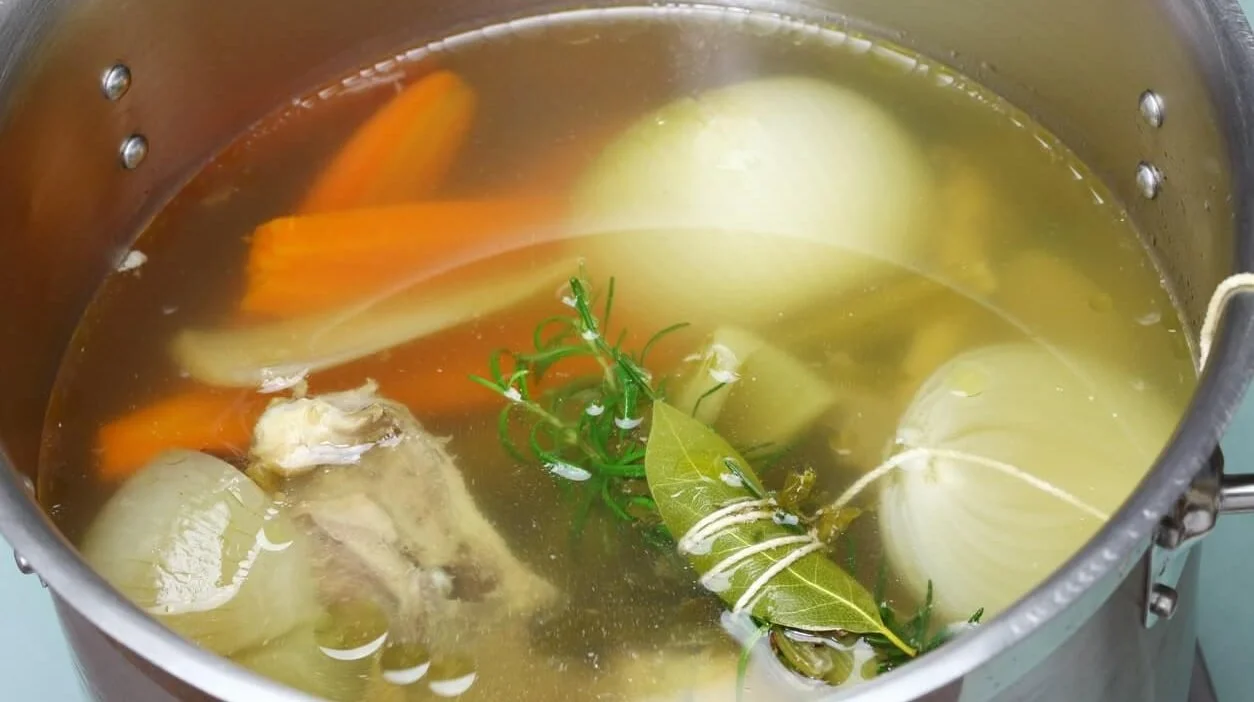How To Make Chicken Stock
Discover > Texas Home Cooking > How To Make Chicken Stock
Fresh chicken (how long does chicken last?) stock is one of my top reasons to only ever buy whole chickens. Once you take the chicken apart you can either freeze the carcass and collect them until you have enough to simmer a huge pot, or you can make a small batch right away and perhaps freeze that.
Let's dive into how to make homemade chicken stock. Making chicken stock at home is easier than one might think. Begin with chicken bones. These can be raw chicken bones, or even leftover bones from a roast chicken. You could also use the chicken carcass from a cooked chicken or whole chicken.
Next, gather your tools. You'll need a large stock pot or a regular stock pot.
Now, let's get into the process of making chicken stock. Throw the bones into the pot, add chopped onion, a few sprigs of fresh thyme, and cover with water. Bring to a simmer, and let it go for at least four hours. You're on your way to creating a delicious homemade stock or chicken broth (how long does chicken broth last?)!
When you're done, pour the stock through a fine mesh strainer to remove the solids. If you've used chicken wings, make sure to take those out first! You can also make homemade chicken broth using this method.
Now, you've got your chicken stock recipe to rival any store-bought stock. That's the beauty of homemade chicken stock - it's fresh, flavorful and you know exactly what goes into it.
How to Make Bone Broth: Simple Steps for a Nutritious Drink
Unlock the secrets of a nutritious and flavorful drink with our simple steps on how to make bone broth - a comforting elixir for health and taste.
Brown VS White Stock
Brown and white stock differ in color, flavor, and method of preparation. Brown stock (which is darker and has a more developed flavor) is made by roasting chicken bones in a hot oven before adding them to cold water. For white stock, the bones are blanched instead of roasted which makes for a paler, lighter, and purer stock.
If you’re making a brown stock, preheat the oven to 400°F, cover the carcass in olive oil (you can also use tomato paste (how long does tomato paste last?), mustard (how long does mustard last?), etc.), transfer the carcass to a roasting tray then push it into the oven and roast for around 25-30 minutes until nicely browned.
To blanch bones for white stock (which removes impurities for a clearer stock), place the bones into a pot, cover them with water, and bring them up to a boil. Simmer the bones for 30 minutes, strain them, then rinse them under cold water. If you blanch the bones in the same pot you intend to make stock in, make sure you give it a quick wash to remove said impurities.
What Can You Add to Stock?
Pure chicken stock without any herbs, spices, or extra vegetables is always appreciated. It’s easy to use because there are no conflicting ingredients, and you can easily season it when you use it to cook. That being said there are a few things you can do to bring it to the next level.
The basic French combination of celery, carrots, and onions is most commonly used to make fresh stock. Garlic, chilis, mushrooms, and fennel (how long does fennel last?) are just a few other options. Roasting the vegetables before adding them to the stock adds a nice layer of flavor. If you’re simmering the stock for 2+ hours, don’t add the vegetables until the final hour of simmering.
Fresh herbs are always the way to go for chicken stock. Some common ones are bay leaves, thyme, parsley, and lemongrass. Whole, toasted spices are how you get the most flavor out of them. It is customary to maintain simplicity by incorporating a combination of toasted and lightly crushed peppercorns.
It is a common practice to refrain from salting stock, as there is a tendency to inadvertently oversalt dishes when using a salty base. Especially if you make a lot of reduction sauces and soups.
How to Make Chicken Stock
Once you’ve roasted or blanched your bones, place them into your stockpot and cover them with cold water. Place the pot over high heat and bring it up to a boil, then bring it down to a simmer.
From the very beginning after the water touches the bones avoid stirring or mixing the stock. There are a lot of impurities that leech out of the bones that mix into the stock for an off-color and flavor. Instead, have a soup spoon ready to skim all the foam and impurities off the surface of the stock again, avoid mixing or disturbing the liquid too much.
You don’t need to simmer the stock for hours and hours to get a nice result. A pot with 2-3 chicken carcasses won’t take longer than 3 hours to complete.
After around two hours of simmering and skimming (when there is around an hour left), add the vegetables and spices to the stock to finish.
Finally, strain the stock and transfer it to a sealable container until ready to use.
Why You Should Ditch Instant Soup Mix & Make Your Own
Discover the reasons behind ditching instant soup mix and embracing the joy of making your own. Our blog explains the benefits of homemade soup for your family.
How to Store Fresh Chicken Stock
There are a couple of things you should look out for when you make fresh stock and one of those things is cooling. There’s a temperature danger zone for hot food that is between 40°F and 140 °F. Certain bacteria can multiply multiple times an hour in these ideal conditions so it’s important to cool it quickly.
By far the easiest way to rapidly cool stock without any high-grade restaurant equipment is to simply give it an ice bath. You can harmlessly add ice cubes to the hot stock and all it’ll do is dilute it, but if you’ve intentionally reduced the stock and don’t want to dilute it; try placing the container of stock into the skink, submerging it in a crushed ice and salt mixture, then stirring constantly until cooled.
If you don’t have any ice or tools to rapidly cool stock there is an alternative. Divide the stock up into smaller portions then place it in a cold place for all the smaller portions to cool.
After cooling you can store the stock in the fridge for up to a week. Alternatively, you can reduce it and freeze it.
Reducing the stock before freezing is done for the sake of space efficiency and convenience. If you reduce stock by 70, 80, or even 90% you can pour the thick mixture into ice cube trays and have easy stock cubes ready.





